(PDF) Management Concepts Assignment
VerifiedAdded on 2021/06/16
|15
|3824
|86
AI Summary
Contribute Materials
Your contribution can guide someone’s learning journey. Share your
documents today.
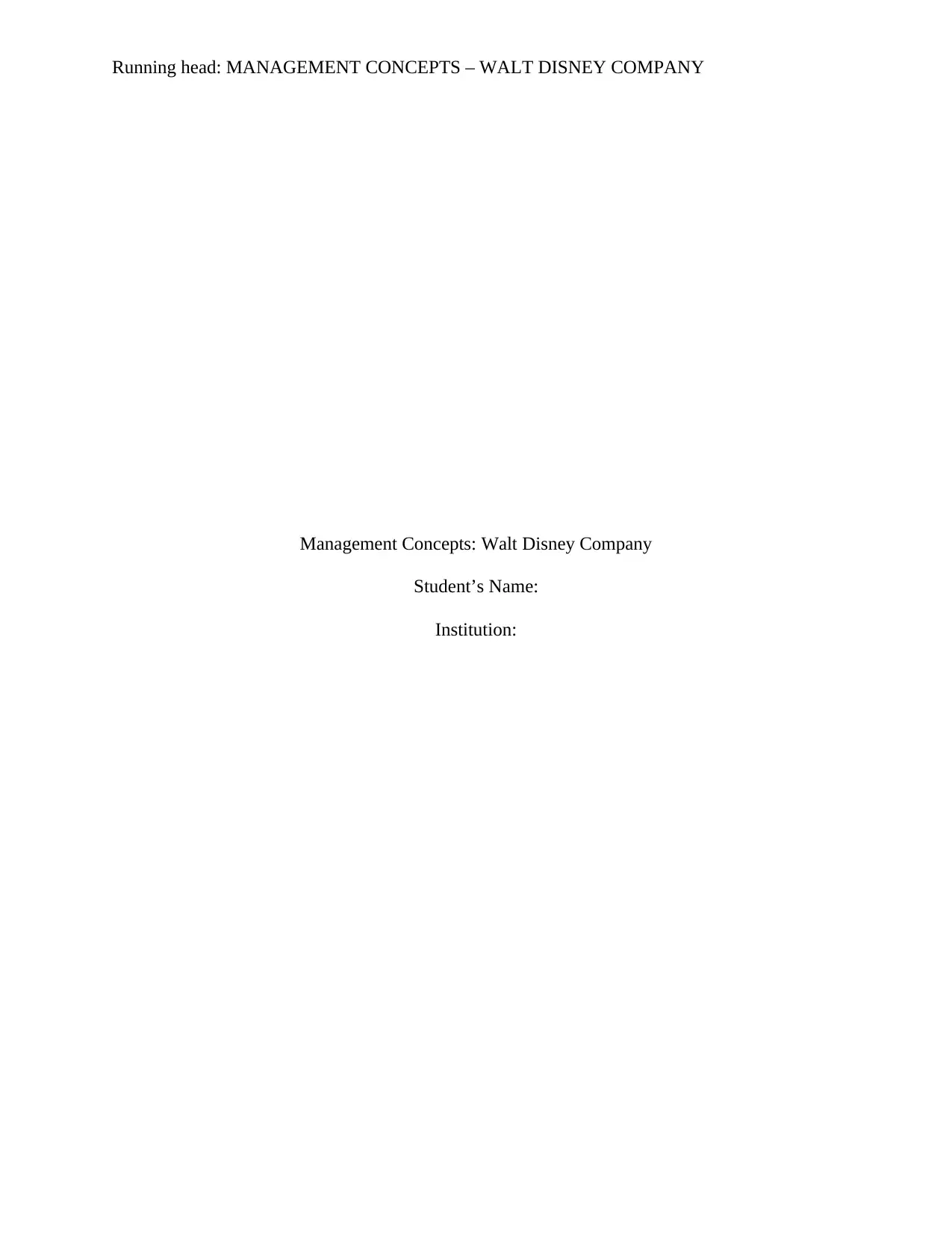
Running head: MANAGEMENT CONCEPTS – WALT DISNEY COMPANY
Management Concepts: Walt Disney Company
Student’s Name:
Institution:
Management Concepts: Walt Disney Company
Student’s Name:
Institution:
Secure Best Marks with AI Grader
Need help grading? Try our AI Grader for instant feedback on your assignments.
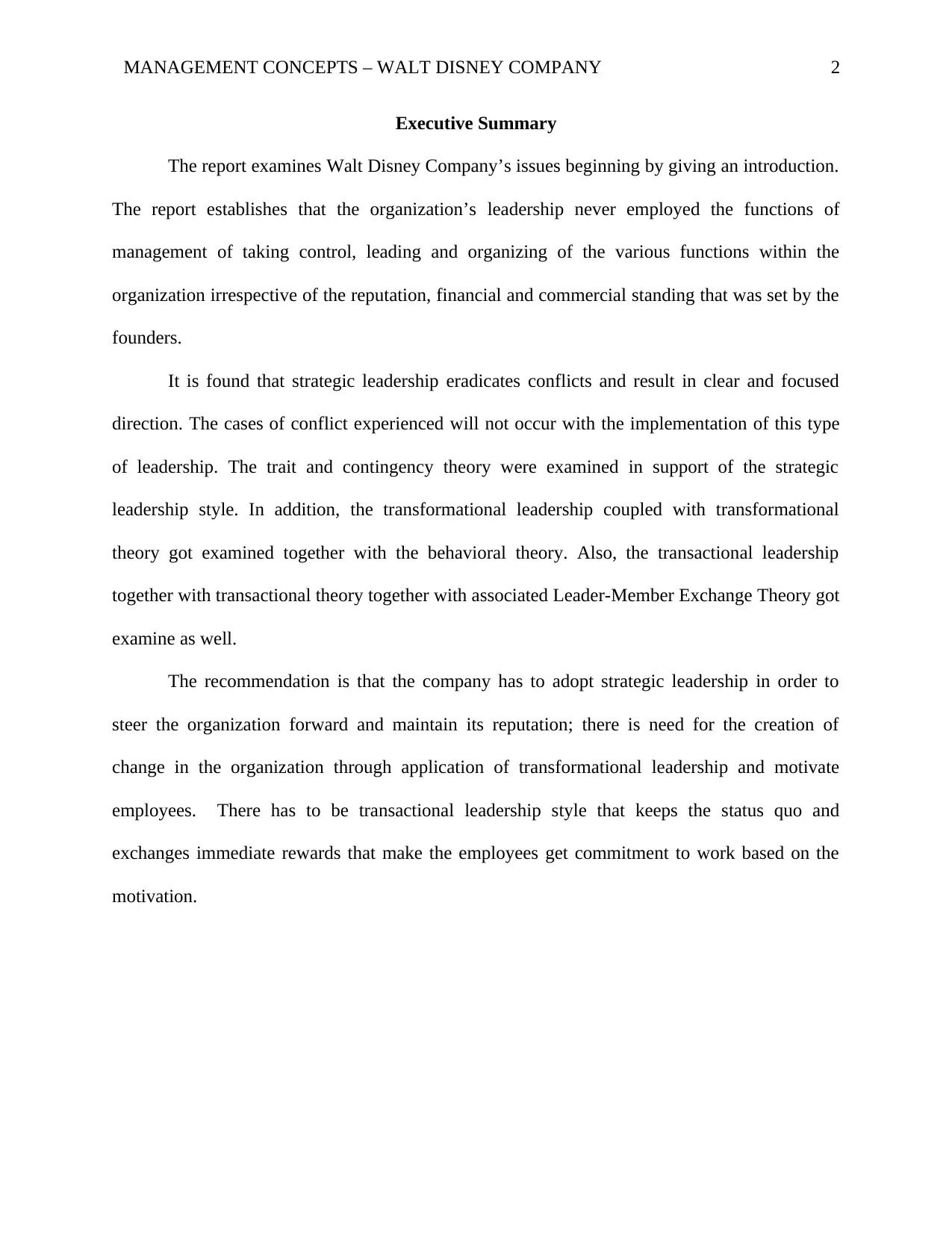
MANAGEMENT CONCEPTS – WALT DISNEY COMPANY 2
Executive Summary
The report examines Walt Disney Company’s issues beginning by giving an introduction.
The report establishes that the organization’s leadership never employed the functions of
management of taking control, leading and organizing of the various functions within the
organization irrespective of the reputation, financial and commercial standing that was set by the
founders.
It is found that strategic leadership eradicates conflicts and result in clear and focused
direction. The cases of conflict experienced will not occur with the implementation of this type
of leadership. The trait and contingency theory were examined in support of the strategic
leadership style. In addition, the transformational leadership coupled with transformational
theory got examined together with the behavioral theory. Also, the transactional leadership
together with transactional theory together with associated Leader-Member Exchange Theory got
examine as well.
The recommendation is that the company has to adopt strategic leadership in order to
steer the organization forward and maintain its reputation; there is need for the creation of
change in the organization through application of transformational leadership and motivate
employees. There has to be transactional leadership style that keeps the status quo and
exchanges immediate rewards that make the employees get commitment to work based on the
motivation.
Executive Summary
The report examines Walt Disney Company’s issues beginning by giving an introduction.
The report establishes that the organization’s leadership never employed the functions of
management of taking control, leading and organizing of the various functions within the
organization irrespective of the reputation, financial and commercial standing that was set by the
founders.
It is found that strategic leadership eradicates conflicts and result in clear and focused
direction. The cases of conflict experienced will not occur with the implementation of this type
of leadership. The trait and contingency theory were examined in support of the strategic
leadership style. In addition, the transformational leadership coupled with transformational
theory got examined together with the behavioral theory. Also, the transactional leadership
together with transactional theory together with associated Leader-Member Exchange Theory got
examine as well.
The recommendation is that the company has to adopt strategic leadership in order to
steer the organization forward and maintain its reputation; there is need for the creation of
change in the organization through application of transformational leadership and motivate
employees. There has to be transactional leadership style that keeps the status quo and
exchanges immediate rewards that make the employees get commitment to work based on the
motivation.
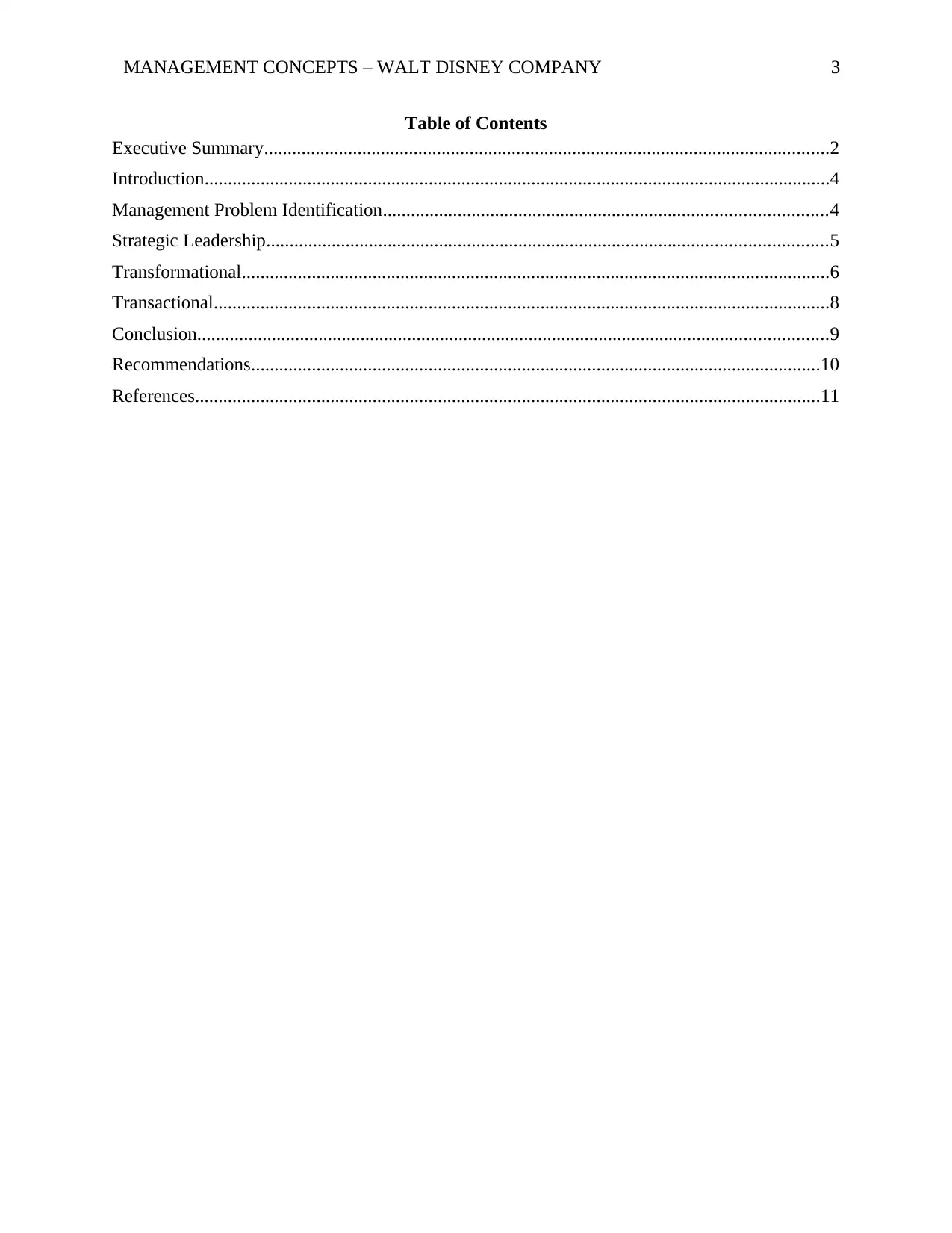
MANAGEMENT CONCEPTS – WALT DISNEY COMPANY 3
Table of Contents
Executive Summary.........................................................................................................................2
Introduction......................................................................................................................................4
Management Problem Identification...............................................................................................4
Strategic Leadership........................................................................................................................5
Transformational..............................................................................................................................6
Transactional....................................................................................................................................8
Conclusion.......................................................................................................................................9
Recommendations..........................................................................................................................10
References......................................................................................................................................11
Table of Contents
Executive Summary.........................................................................................................................2
Introduction......................................................................................................................................4
Management Problem Identification...............................................................................................4
Strategic Leadership........................................................................................................................5
Transformational..............................................................................................................................6
Transactional....................................................................................................................................8
Conclusion.......................................................................................................................................9
Recommendations..........................................................................................................................10
References......................................................................................................................................11
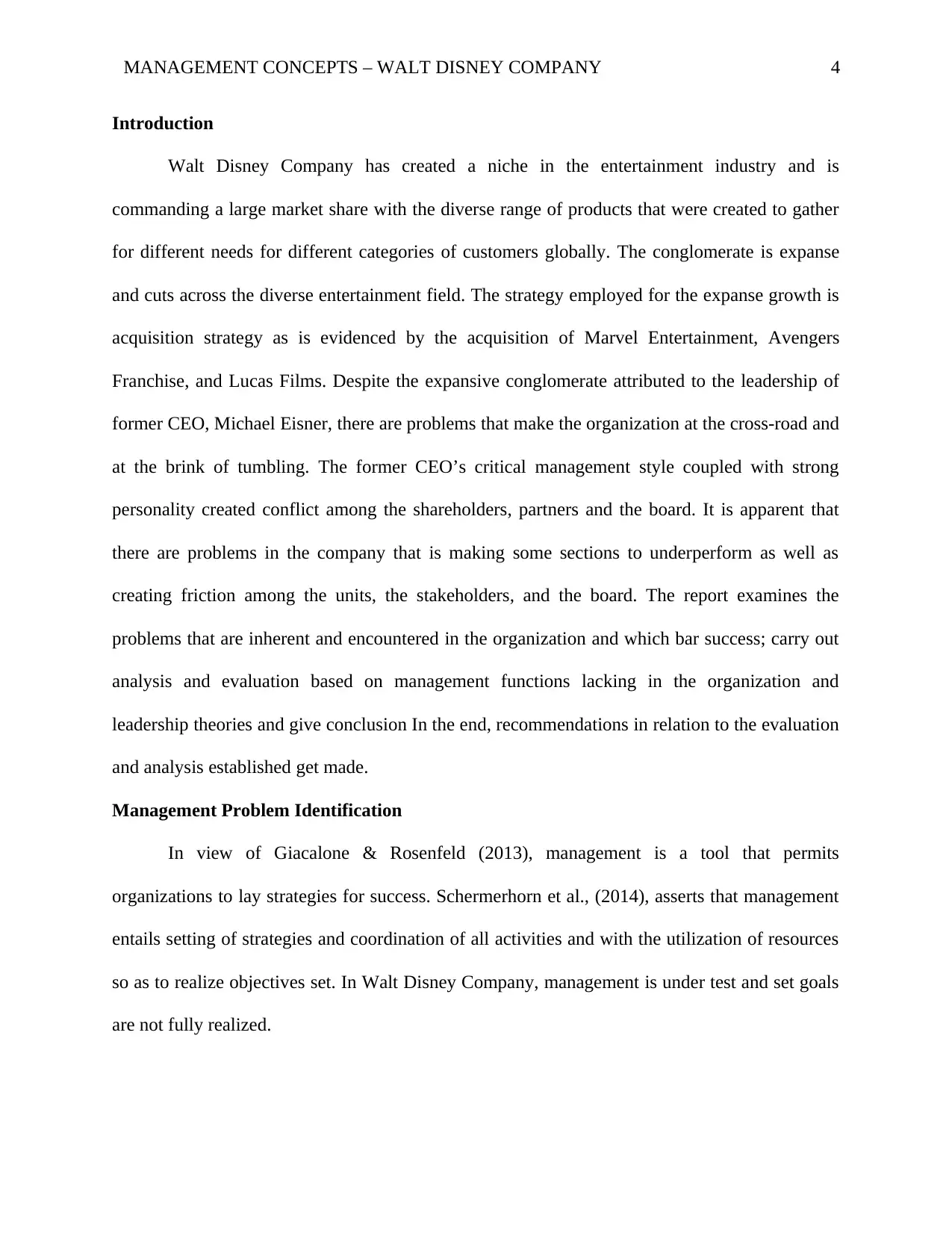
MANAGEMENT CONCEPTS – WALT DISNEY COMPANY 4
Introduction
Walt Disney Company has created a niche in the entertainment industry and is
commanding a large market share with the diverse range of products that were created to gather
for different needs for different categories of customers globally. The conglomerate is expanse
and cuts across the diverse entertainment field. The strategy employed for the expanse growth is
acquisition strategy as is evidenced by the acquisition of Marvel Entertainment, Avengers
Franchise, and Lucas Films. Despite the expansive conglomerate attributed to the leadership of
former CEO, Michael Eisner, there are problems that make the organization at the cross-road and
at the brink of tumbling. The former CEO’s critical management style coupled with strong
personality created conflict among the shareholders, partners and the board. It is apparent that
there are problems in the company that is making some sections to underperform as well as
creating friction among the units, the stakeholders, and the board. The report examines the
problems that are inherent and encountered in the organization and which bar success; carry out
analysis and evaluation based on management functions lacking in the organization and
leadership theories and give conclusion In the end, recommendations in relation to the evaluation
and analysis established get made.
Management Problem Identification
In view of Giacalone & Rosenfeld (2013), management is a tool that permits
organizations to lay strategies for success. Schermerhorn et al., (2014), asserts that management
entails setting of strategies and coordination of all activities and with the utilization of resources
so as to realize objectives set. In Walt Disney Company, management is under test and set goals
are not fully realized.
Introduction
Walt Disney Company has created a niche in the entertainment industry and is
commanding a large market share with the diverse range of products that were created to gather
for different needs for different categories of customers globally. The conglomerate is expanse
and cuts across the diverse entertainment field. The strategy employed for the expanse growth is
acquisition strategy as is evidenced by the acquisition of Marvel Entertainment, Avengers
Franchise, and Lucas Films. Despite the expansive conglomerate attributed to the leadership of
former CEO, Michael Eisner, there are problems that make the organization at the cross-road and
at the brink of tumbling. The former CEO’s critical management style coupled with strong
personality created conflict among the shareholders, partners and the board. It is apparent that
there are problems in the company that is making some sections to underperform as well as
creating friction among the units, the stakeholders, and the board. The report examines the
problems that are inherent and encountered in the organization and which bar success; carry out
analysis and evaluation based on management functions lacking in the organization and
leadership theories and give conclusion In the end, recommendations in relation to the evaluation
and analysis established get made.
Management Problem Identification
In view of Giacalone & Rosenfeld (2013), management is a tool that permits
organizations to lay strategies for success. Schermerhorn et al., (2014), asserts that management
entails setting of strategies and coordination of all activities and with the utilization of resources
so as to realize objectives set. In Walt Disney Company, management is under test and set goals
are not fully realized.
Secure Best Marks with AI Grader
Need help grading? Try our AI Grader for instant feedback on your assignments.

MANAGEMENT CONCEPTS – WALT DISNEY COMPANY 5
Michael Eisner’s leadership style was autocratic. Du et al., (2013) asserts that autocratic
style of leading bestows all the authority and responsibility to one central point - the leader and
there is no question because the boss is final and communication. The direction of instruction
emanates from the top and this is the disadvantage of the leadership style as it creates conflict
among peers (Amanchukwu, Stanley & Ololube, 2015).
Additionally, there is the problem of control where Job needs to have total control of
Pixar, the issues of finances and creation of films to be under Pixa. As per Buble, Juras & Matić,
(2014), the control being a function of management permits an organization to run its activities
based on selected leadership style coupled with motivation expected harmoniously. The benefits
enjoyed through Pixar made Michael Eisner resist releasing its control as an entity whereas Job
perceives that there is no advantage gained from Pixar unless they are in control of the entire
section (Keskes, 2014).
Moreover, organizing is another problem seen at Walt Disney Company. The product
brands like Mickey Mouse and Winnie-the-Pooh available and active in the organization have
remained unchanged for a long time irrespective of the fact that these brands still command over
80% of the customers. The target market for Mickey Mouse and Winnie-the-Pooh are intended
for young children. This leaves out preteens who are equally a large market. Alongside this, the
quality of the production is low, poor acting and the scripts are weak. The other products such as
Senior Year, Movies High, Bolt, Bedtime Stories among others failed to attract customers and
therefore did not meet the set goals.
Strategic Leadership
There is no strategic leadership at Walt Disney Company and it is the cause of the
problems encountered. As per Hill, Jones & Schilling (2014), strategic leadership approach is not
Michael Eisner’s leadership style was autocratic. Du et al., (2013) asserts that autocratic
style of leading bestows all the authority and responsibility to one central point - the leader and
there is no question because the boss is final and communication. The direction of instruction
emanates from the top and this is the disadvantage of the leadership style as it creates conflict
among peers (Amanchukwu, Stanley & Ololube, 2015).
Additionally, there is the problem of control where Job needs to have total control of
Pixar, the issues of finances and creation of films to be under Pixa. As per Buble, Juras & Matić,
(2014), the control being a function of management permits an organization to run its activities
based on selected leadership style coupled with motivation expected harmoniously. The benefits
enjoyed through Pixar made Michael Eisner resist releasing its control as an entity whereas Job
perceives that there is no advantage gained from Pixar unless they are in control of the entire
section (Keskes, 2014).
Moreover, organizing is another problem seen at Walt Disney Company. The product
brands like Mickey Mouse and Winnie-the-Pooh available and active in the organization have
remained unchanged for a long time irrespective of the fact that these brands still command over
80% of the customers. The target market for Mickey Mouse and Winnie-the-Pooh are intended
for young children. This leaves out preteens who are equally a large market. Alongside this, the
quality of the production is low, poor acting and the scripts are weak. The other products such as
Senior Year, Movies High, Bolt, Bedtime Stories among others failed to attract customers and
therefore did not meet the set goals.
Strategic Leadership
There is no strategic leadership at Walt Disney Company and it is the cause of the
problems encountered. As per Hill, Jones & Schilling (2014), strategic leadership approach is not
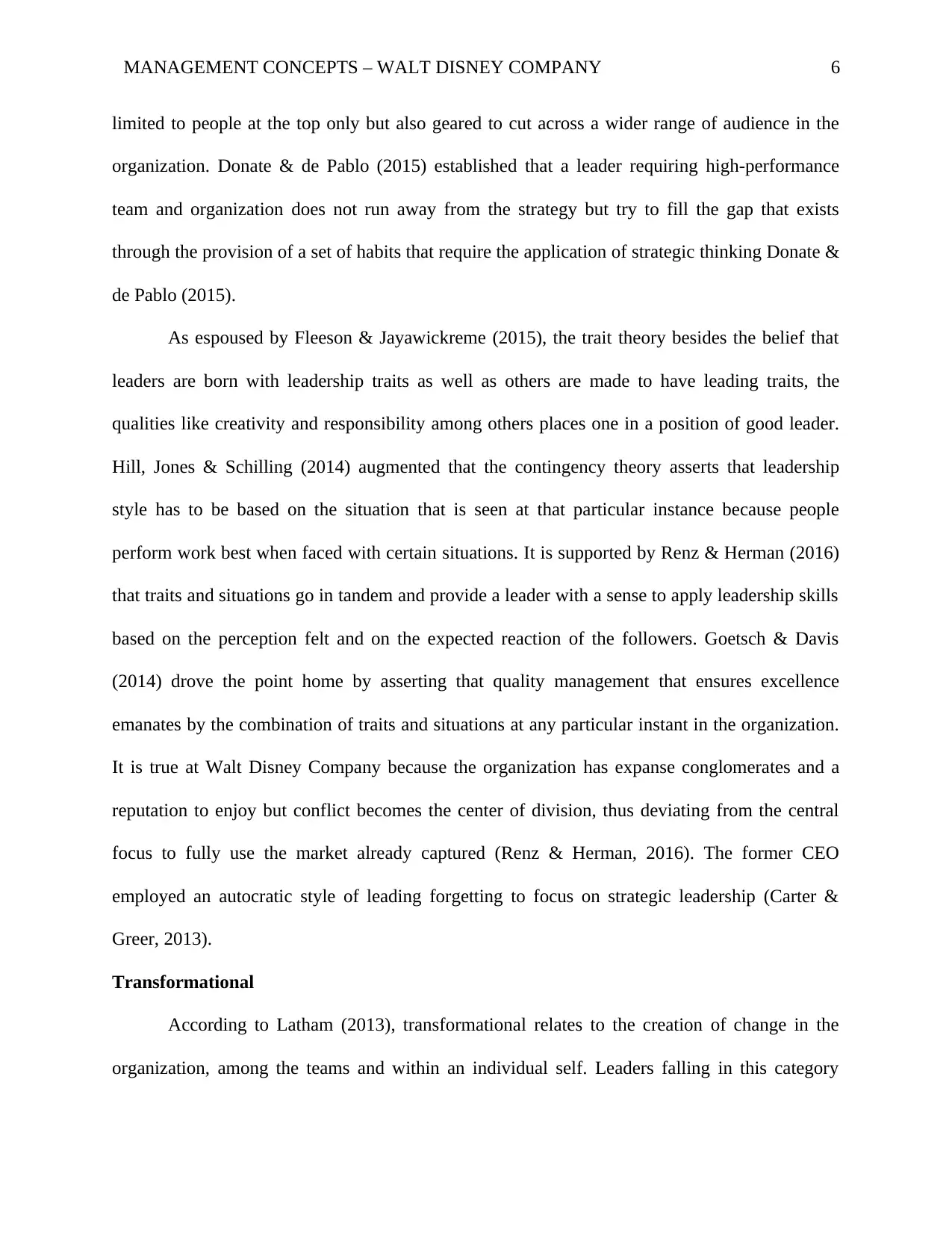
MANAGEMENT CONCEPTS – WALT DISNEY COMPANY 6
limited to people at the top only but also geared to cut across a wider range of audience in the
organization. Donate & de Pablo (2015) established that a leader requiring high-performance
team and organization does not run away from the strategy but try to fill the gap that exists
through the provision of a set of habits that require the application of strategic thinking Donate &
de Pablo (2015).
As espoused by Fleeson & Jayawickreme (2015), the trait theory besides the belief that
leaders are born with leadership traits as well as others are made to have leading traits, the
qualities like creativity and responsibility among others places one in a position of good leader.
Hill, Jones & Schilling (2014) augmented that the contingency theory asserts that leadership
style has to be based on the situation that is seen at that particular instance because people
perform work best when faced with certain situations. It is supported by Renz & Herman (2016)
that traits and situations go in tandem and provide a leader with a sense to apply leadership skills
based on the perception felt and on the expected reaction of the followers. Goetsch & Davis
(2014) drove the point home by asserting that quality management that ensures excellence
emanates by the combination of traits and situations at any particular instant in the organization.
It is true at Walt Disney Company because the organization has expanse conglomerates and a
reputation to enjoy but conflict becomes the center of division, thus deviating from the central
focus to fully use the market already captured (Renz & Herman, 2016). The former CEO
employed an autocratic style of leading forgetting to focus on strategic leadership (Carter &
Greer, 2013).
Transformational
According to Latham (2013), transformational relates to the creation of change in the
organization, among the teams and within an individual self. Leaders falling in this category
limited to people at the top only but also geared to cut across a wider range of audience in the
organization. Donate & de Pablo (2015) established that a leader requiring high-performance
team and organization does not run away from the strategy but try to fill the gap that exists
through the provision of a set of habits that require the application of strategic thinking Donate &
de Pablo (2015).
As espoused by Fleeson & Jayawickreme (2015), the trait theory besides the belief that
leaders are born with leadership traits as well as others are made to have leading traits, the
qualities like creativity and responsibility among others places one in a position of good leader.
Hill, Jones & Schilling (2014) augmented that the contingency theory asserts that leadership
style has to be based on the situation that is seen at that particular instance because people
perform work best when faced with certain situations. It is supported by Renz & Herman (2016)
that traits and situations go in tandem and provide a leader with a sense to apply leadership skills
based on the perception felt and on the expected reaction of the followers. Goetsch & Davis
(2014) drove the point home by asserting that quality management that ensures excellence
emanates by the combination of traits and situations at any particular instant in the organization.
It is true at Walt Disney Company because the organization has expanse conglomerates and a
reputation to enjoy but conflict becomes the center of division, thus deviating from the central
focus to fully use the market already captured (Renz & Herman, 2016). The former CEO
employed an autocratic style of leading forgetting to focus on strategic leadership (Carter &
Greer, 2013).
Transformational
According to Latham (2013), transformational relates to the creation of change in the
organization, among the teams and within an individual self. Leaders falling in this category
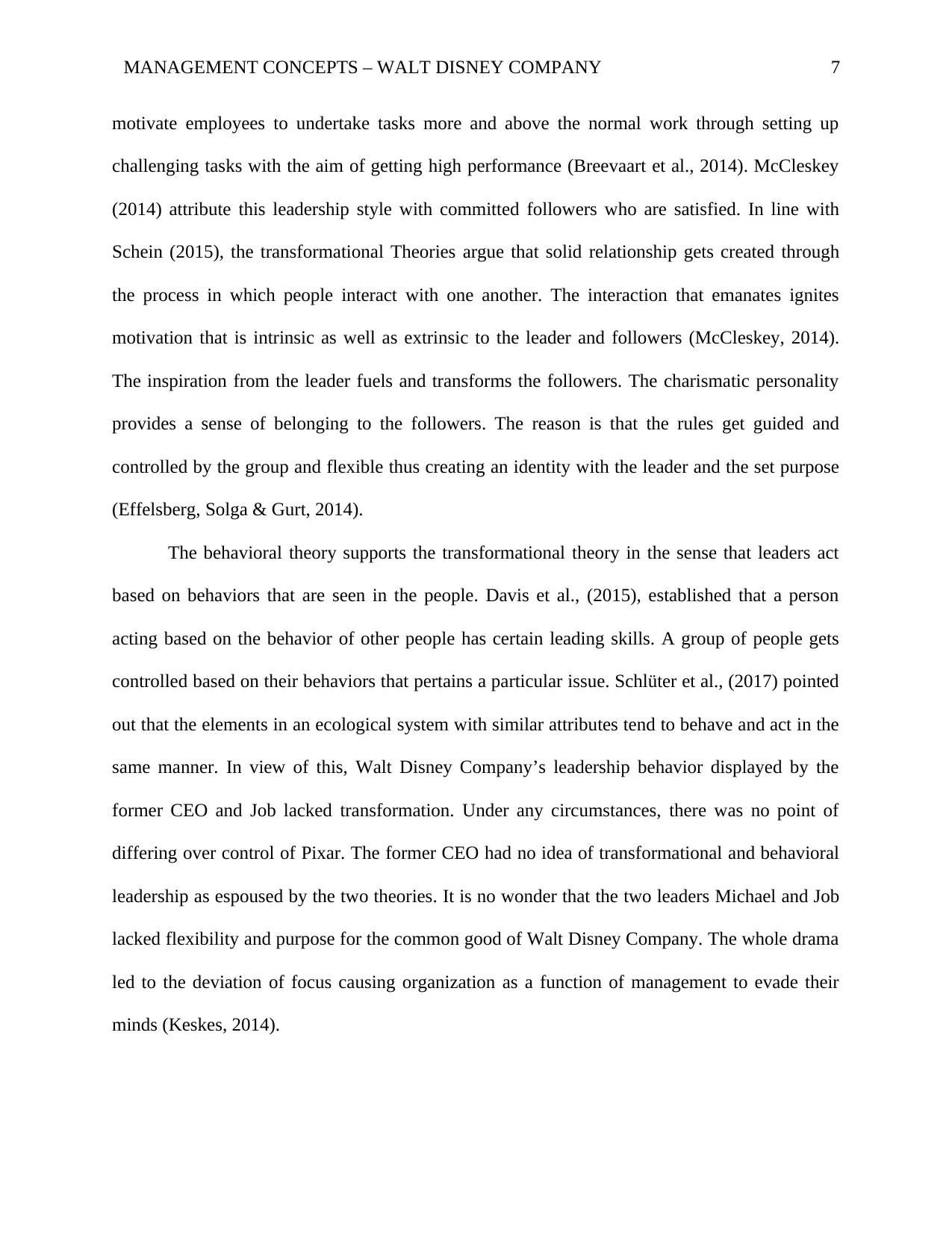
MANAGEMENT CONCEPTS – WALT DISNEY COMPANY 7
motivate employees to undertake tasks more and above the normal work through setting up
challenging tasks with the aim of getting high performance (Breevaart et al., 2014). McCleskey
(2014) attribute this leadership style with committed followers who are satisfied. In line with
Schein (2015), the transformational Theories argue that solid relationship gets created through
the process in which people interact with one another. The interaction that emanates ignites
motivation that is intrinsic as well as extrinsic to the leader and followers (McCleskey, 2014).
The inspiration from the leader fuels and transforms the followers. The charismatic personality
provides a sense of belonging to the followers. The reason is that the rules get guided and
controlled by the group and flexible thus creating an identity with the leader and the set purpose
(Effelsberg, Solga & Gurt, 2014).
The behavioral theory supports the transformational theory in the sense that leaders act
based on behaviors that are seen in the people. Davis et al., (2015), established that a person
acting based on the behavior of other people has certain leading skills. A group of people gets
controlled based on their behaviors that pertains a particular issue. Schlüter et al., (2017) pointed
out that the elements in an ecological system with similar attributes tend to behave and act in the
same manner. In view of this, Walt Disney Company’s leadership behavior displayed by the
former CEO and Job lacked transformation. Under any circumstances, there was no point of
differing over control of Pixar. The former CEO had no idea of transformational and behavioral
leadership as espoused by the two theories. It is no wonder that the two leaders Michael and Job
lacked flexibility and purpose for the common good of Walt Disney Company. The whole drama
led to the deviation of focus causing organization as a function of management to evade their
minds (Keskes, 2014).
motivate employees to undertake tasks more and above the normal work through setting up
challenging tasks with the aim of getting high performance (Breevaart et al., 2014). McCleskey
(2014) attribute this leadership style with committed followers who are satisfied. In line with
Schein (2015), the transformational Theories argue that solid relationship gets created through
the process in which people interact with one another. The interaction that emanates ignites
motivation that is intrinsic as well as extrinsic to the leader and followers (McCleskey, 2014).
The inspiration from the leader fuels and transforms the followers. The charismatic personality
provides a sense of belonging to the followers. The reason is that the rules get guided and
controlled by the group and flexible thus creating an identity with the leader and the set purpose
(Effelsberg, Solga & Gurt, 2014).
The behavioral theory supports the transformational theory in the sense that leaders act
based on behaviors that are seen in the people. Davis et al., (2015), established that a person
acting based on the behavior of other people has certain leading skills. A group of people gets
controlled based on their behaviors that pertains a particular issue. Schlüter et al., (2017) pointed
out that the elements in an ecological system with similar attributes tend to behave and act in the
same manner. In view of this, Walt Disney Company’s leadership behavior displayed by the
former CEO and Job lacked transformation. Under any circumstances, there was no point of
differing over control of Pixar. The former CEO had no idea of transformational and behavioral
leadership as espoused by the two theories. It is no wonder that the two leaders Michael and Job
lacked flexibility and purpose for the common good of Walt Disney Company. The whole drama
led to the deviation of focus causing organization as a function of management to evade their
minds (Keskes, 2014).
Paraphrase This Document
Need a fresh take? Get an instant paraphrase of this document with our AI Paraphraser
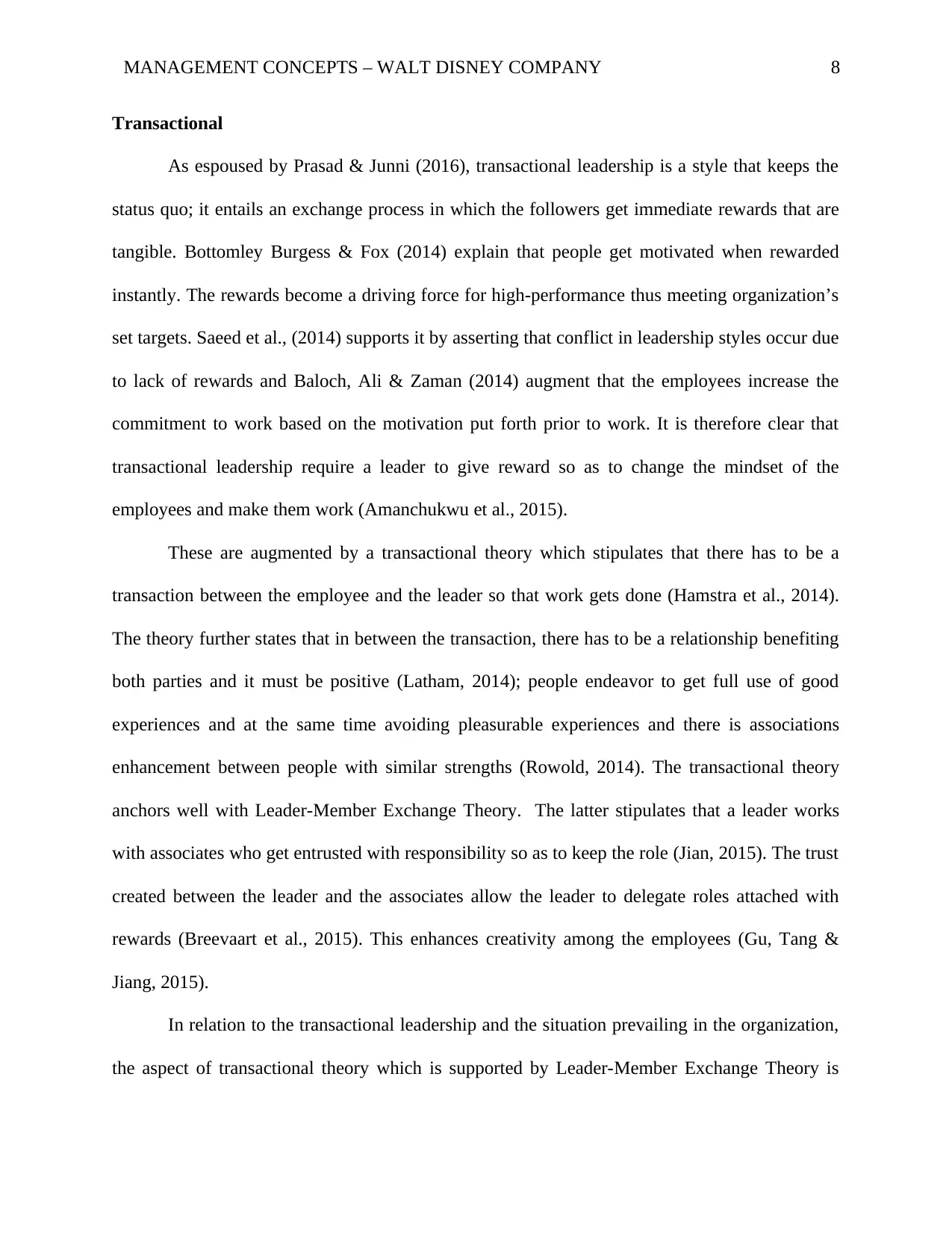
MANAGEMENT CONCEPTS – WALT DISNEY COMPANY 8
Transactional
As espoused by Prasad & Junni (2016), transactional leadership is a style that keeps the
status quo; it entails an exchange process in which the followers get immediate rewards that are
tangible. Bottomley Burgess & Fox (2014) explain that people get motivated when rewarded
instantly. The rewards become a driving force for high-performance thus meeting organization’s
set targets. Saeed et al., (2014) supports it by asserting that conflict in leadership styles occur due
to lack of rewards and Baloch, Ali & Zaman (2014) augment that the employees increase the
commitment to work based on the motivation put forth prior to work. It is therefore clear that
transactional leadership require a leader to give reward so as to change the mindset of the
employees and make them work (Amanchukwu et al., 2015).
These are augmented by a transactional theory which stipulates that there has to be a
transaction between the employee and the leader so that work gets done (Hamstra et al., 2014).
The theory further states that in between the transaction, there has to be a relationship benefiting
both parties and it must be positive (Latham, 2014); people endeavor to get full use of good
experiences and at the same time avoiding pleasurable experiences and there is associations
enhancement between people with similar strengths (Rowold, 2014). The transactional theory
anchors well with Leader-Member Exchange Theory. The latter stipulates that a leader works
with associates who get entrusted with responsibility so as to keep the role (Jian, 2015). The trust
created between the leader and the associates allow the leader to delegate roles attached with
rewards (Breevaart et al., 2015). This enhances creativity among the employees (Gu, Tang &
Jiang, 2015).
In relation to the transactional leadership and the situation prevailing in the organization,
the aspect of transactional theory which is supported by Leader-Member Exchange Theory is
Transactional
As espoused by Prasad & Junni (2016), transactional leadership is a style that keeps the
status quo; it entails an exchange process in which the followers get immediate rewards that are
tangible. Bottomley Burgess & Fox (2014) explain that people get motivated when rewarded
instantly. The rewards become a driving force for high-performance thus meeting organization’s
set targets. Saeed et al., (2014) supports it by asserting that conflict in leadership styles occur due
to lack of rewards and Baloch, Ali & Zaman (2014) augment that the employees increase the
commitment to work based on the motivation put forth prior to work. It is therefore clear that
transactional leadership require a leader to give reward so as to change the mindset of the
employees and make them work (Amanchukwu et al., 2015).
These are augmented by a transactional theory which stipulates that there has to be a
transaction between the employee and the leader so that work gets done (Hamstra et al., 2014).
The theory further states that in between the transaction, there has to be a relationship benefiting
both parties and it must be positive (Latham, 2014); people endeavor to get full use of good
experiences and at the same time avoiding pleasurable experiences and there is associations
enhancement between people with similar strengths (Rowold, 2014). The transactional theory
anchors well with Leader-Member Exchange Theory. The latter stipulates that a leader works
with associates who get entrusted with responsibility so as to keep the role (Jian, 2015). The trust
created between the leader and the associates allow the leader to delegate roles attached with
rewards (Breevaart et al., 2015). This enhances creativity among the employees (Gu, Tang &
Jiang, 2015).
In relation to the transactional leadership and the situation prevailing in the organization,
the aspect of transactional theory which is supported by Leader-Member Exchange Theory is
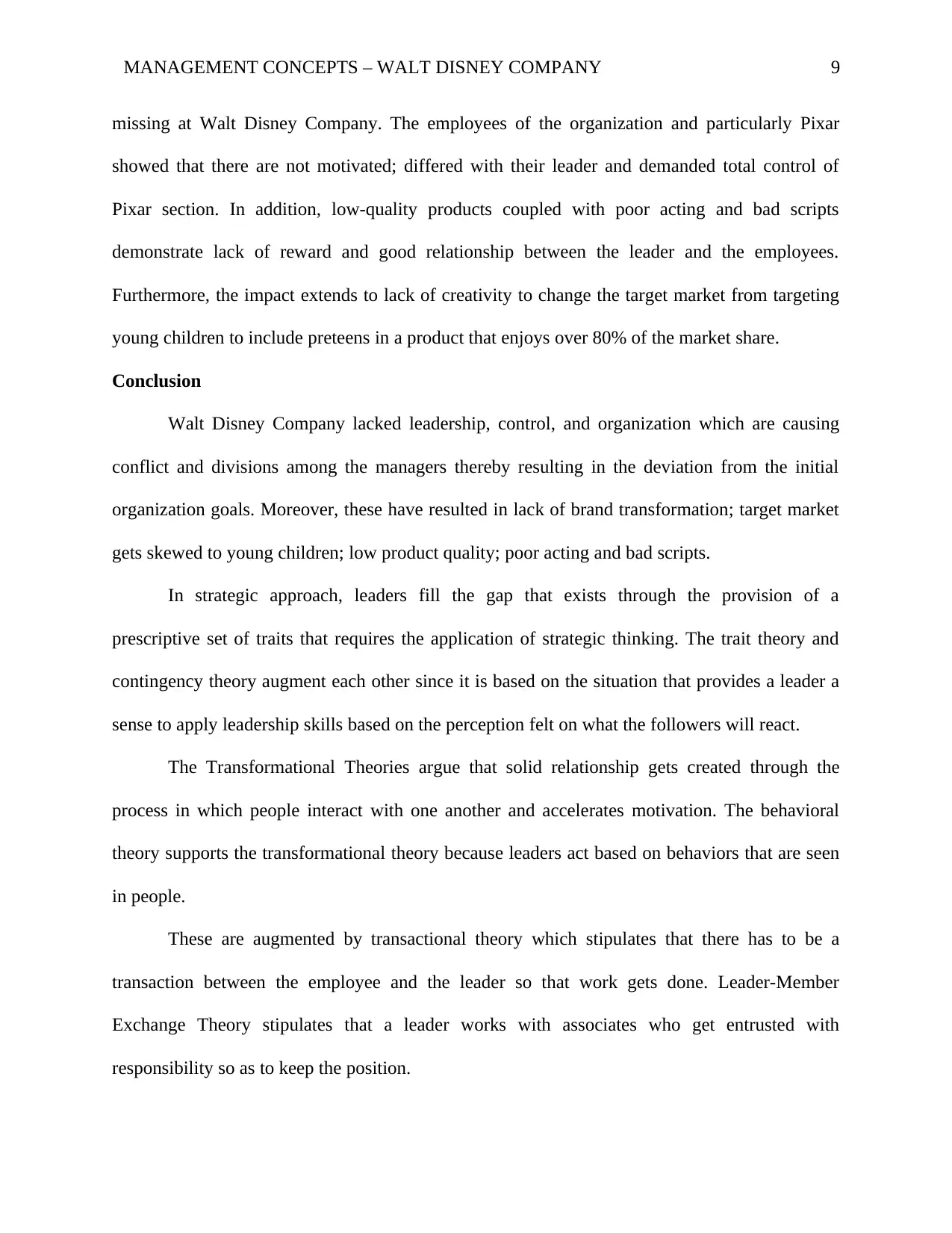
MANAGEMENT CONCEPTS – WALT DISNEY COMPANY 9
missing at Walt Disney Company. The employees of the organization and particularly Pixar
showed that there are not motivated; differed with their leader and demanded total control of
Pixar section. In addition, low-quality products coupled with poor acting and bad scripts
demonstrate lack of reward and good relationship between the leader and the employees.
Furthermore, the impact extends to lack of creativity to change the target market from targeting
young children to include preteens in a product that enjoys over 80% of the market share.
Conclusion
Walt Disney Company lacked leadership, control, and organization which are causing
conflict and divisions among the managers thereby resulting in the deviation from the initial
organization goals. Moreover, these have resulted in lack of brand transformation; target market
gets skewed to young children; low product quality; poor acting and bad scripts.
In strategic approach, leaders fill the gap that exists through the provision of a
prescriptive set of traits that requires the application of strategic thinking. The trait theory and
contingency theory augment each other since it is based on the situation that provides a leader a
sense to apply leadership skills based on the perception felt on what the followers will react.
The Transformational Theories argue that solid relationship gets created through the
process in which people interact with one another and accelerates motivation. The behavioral
theory supports the transformational theory because leaders act based on behaviors that are seen
in people.
These are augmented by transactional theory which stipulates that there has to be a
transaction between the employee and the leader so that work gets done. Leader-Member
Exchange Theory stipulates that a leader works with associates who get entrusted with
responsibility so as to keep the position.
missing at Walt Disney Company. The employees of the organization and particularly Pixar
showed that there are not motivated; differed with their leader and demanded total control of
Pixar section. In addition, low-quality products coupled with poor acting and bad scripts
demonstrate lack of reward and good relationship between the leader and the employees.
Furthermore, the impact extends to lack of creativity to change the target market from targeting
young children to include preteens in a product that enjoys over 80% of the market share.
Conclusion
Walt Disney Company lacked leadership, control, and organization which are causing
conflict and divisions among the managers thereby resulting in the deviation from the initial
organization goals. Moreover, these have resulted in lack of brand transformation; target market
gets skewed to young children; low product quality; poor acting and bad scripts.
In strategic approach, leaders fill the gap that exists through the provision of a
prescriptive set of traits that requires the application of strategic thinking. The trait theory and
contingency theory augment each other since it is based on the situation that provides a leader a
sense to apply leadership skills based on the perception felt on what the followers will react.
The Transformational Theories argue that solid relationship gets created through the
process in which people interact with one another and accelerates motivation. The behavioral
theory supports the transformational theory because leaders act based on behaviors that are seen
in people.
These are augmented by transactional theory which stipulates that there has to be a
transaction between the employee and the leader so that work gets done. Leader-Member
Exchange Theory stipulates that a leader works with associates who get entrusted with
responsibility so as to keep the position.
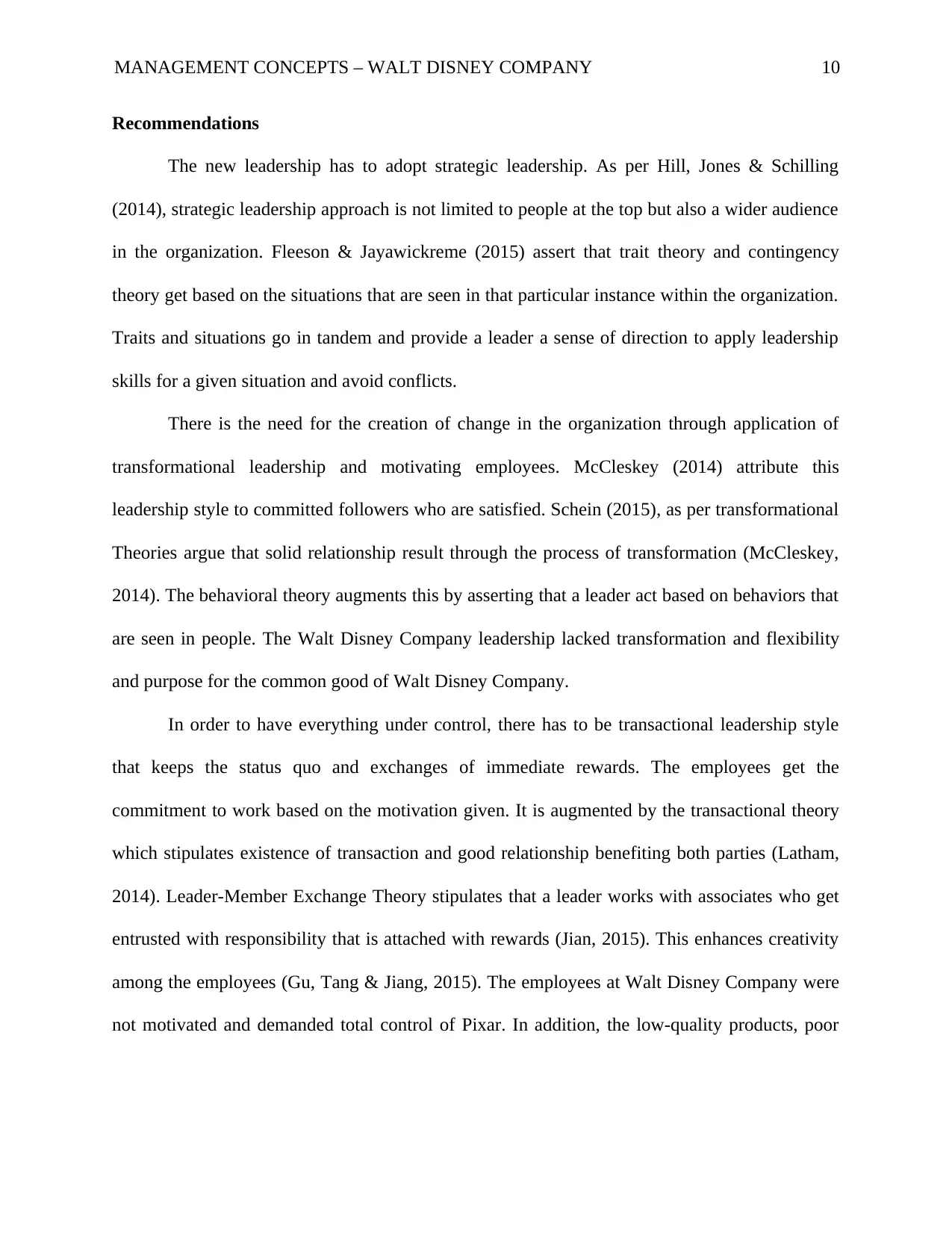
MANAGEMENT CONCEPTS – WALT DISNEY COMPANY 10
Recommendations
The new leadership has to adopt strategic leadership. As per Hill, Jones & Schilling
(2014), strategic leadership approach is not limited to people at the top but also a wider audience
in the organization. Fleeson & Jayawickreme (2015) assert that trait theory and contingency
theory get based on the situations that are seen in that particular instance within the organization.
Traits and situations go in tandem and provide a leader a sense of direction to apply leadership
skills for a given situation and avoid conflicts.
There is the need for the creation of change in the organization through application of
transformational leadership and motivating employees. McCleskey (2014) attribute this
leadership style to committed followers who are satisfied. Schein (2015), as per transformational
Theories argue that solid relationship result through the process of transformation (McCleskey,
2014). The behavioral theory augments this by asserting that a leader act based on behaviors that
are seen in people. The Walt Disney Company leadership lacked transformation and flexibility
and purpose for the common good of Walt Disney Company.
In order to have everything under control, there has to be transactional leadership style
that keeps the status quo and exchanges of immediate rewards. The employees get the
commitment to work based on the motivation given. It is augmented by the transactional theory
which stipulates existence of transaction and good relationship benefiting both parties (Latham,
2014). Leader-Member Exchange Theory stipulates that a leader works with associates who get
entrusted with responsibility that is attached with rewards (Jian, 2015). This enhances creativity
among the employees (Gu, Tang & Jiang, 2015). The employees at Walt Disney Company were
not motivated and demanded total control of Pixar. In addition, the low-quality products, poor
Recommendations
The new leadership has to adopt strategic leadership. As per Hill, Jones & Schilling
(2014), strategic leadership approach is not limited to people at the top but also a wider audience
in the organization. Fleeson & Jayawickreme (2015) assert that trait theory and contingency
theory get based on the situations that are seen in that particular instance within the organization.
Traits and situations go in tandem and provide a leader a sense of direction to apply leadership
skills for a given situation and avoid conflicts.
There is the need for the creation of change in the organization through application of
transformational leadership and motivating employees. McCleskey (2014) attribute this
leadership style to committed followers who are satisfied. Schein (2015), as per transformational
Theories argue that solid relationship result through the process of transformation (McCleskey,
2014). The behavioral theory augments this by asserting that a leader act based on behaviors that
are seen in people. The Walt Disney Company leadership lacked transformation and flexibility
and purpose for the common good of Walt Disney Company.
In order to have everything under control, there has to be transactional leadership style
that keeps the status quo and exchanges of immediate rewards. The employees get the
commitment to work based on the motivation given. It is augmented by the transactional theory
which stipulates existence of transaction and good relationship benefiting both parties (Latham,
2014). Leader-Member Exchange Theory stipulates that a leader works with associates who get
entrusted with responsibility that is attached with rewards (Jian, 2015). This enhances creativity
among the employees (Gu, Tang & Jiang, 2015). The employees at Walt Disney Company were
not motivated and demanded total control of Pixar. In addition, the low-quality products, poor
Secure Best Marks with AI Grader
Need help grading? Try our AI Grader for instant feedback on your assignments.
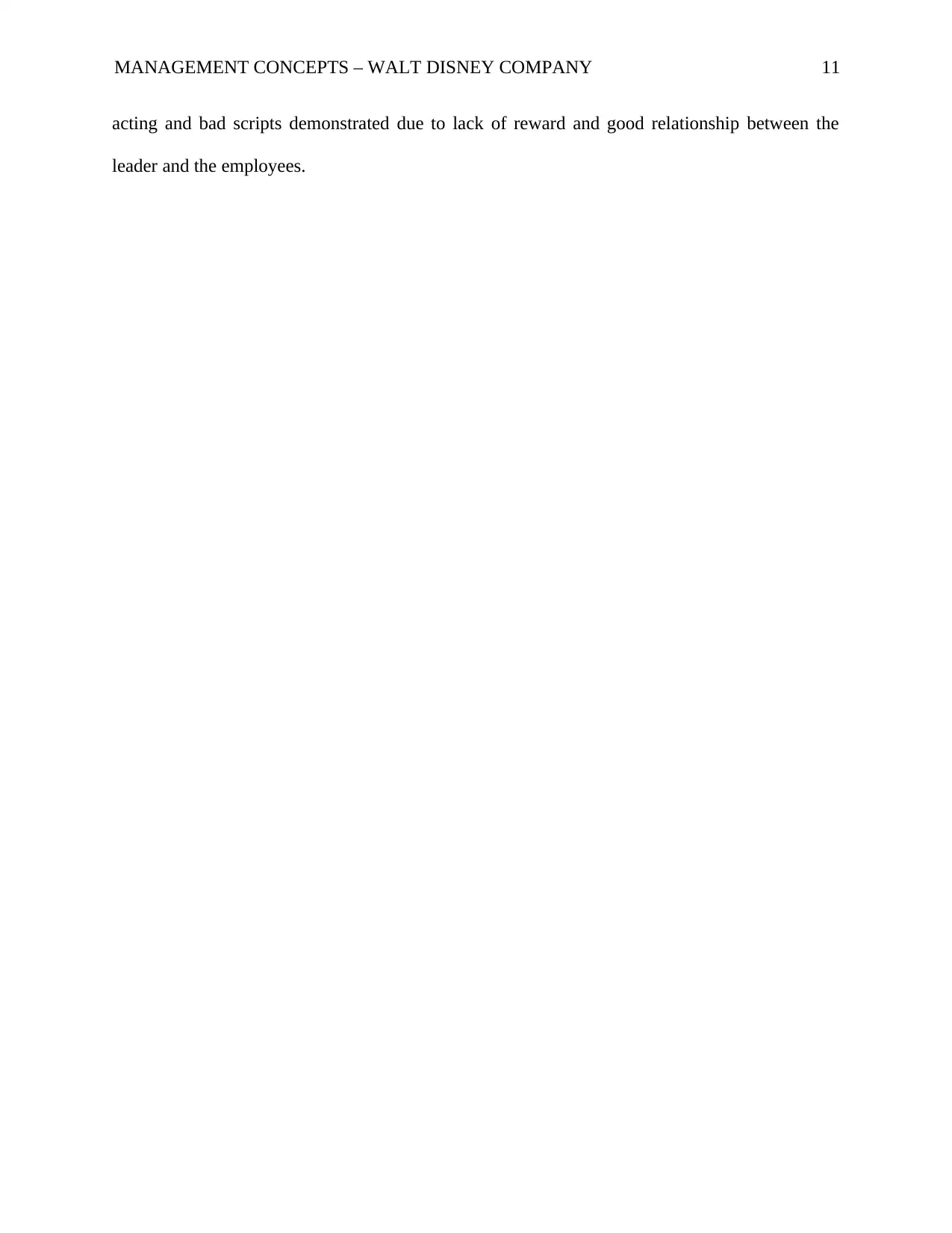
MANAGEMENT CONCEPTS – WALT DISNEY COMPANY 11
acting and bad scripts demonstrated due to lack of reward and good relationship between the
leader and the employees.
acting and bad scripts demonstrated due to lack of reward and good relationship between the
leader and the employees.

MANAGEMENT CONCEPTS – WALT DISNEY COMPANY 12
References
Amanchukwu, R. N., Stanley, G. J., & Ololube, N. P. (2015). A review of leadership theories,
principles and styles and their relevance to educational management. Management, 5(1),
6-14.
Baloch, Q. B., Ali, N., & Zaman, G. (2014). Measuring employees commitment as outcome of
transformational and transactional leadership styles: an empirical study. Abasyn Journal
of Social Sciences, 3(2), 208-214.
Bottomley, K., Burgess, S., & Fox III, M. (2014). Are the behaviors of transformational leaders
impacting organizations? A study of transformational leadership. International
Management Review, 10(1), 5.
Breevaart, K., Bakker, A. B., Demerouti, E., & van den Heuvel, M. (2015). Leader-member
exchange, work engagement, and job performance. Journal of Managerial Psychology,
30(7), 754-770.
Breevaart, K., Bakker, A., Hetland, J., Demerouti, E., Olsen, O. K., & Espevik, R. (2014). Daily
transactional and transformational leadership and daily employee engagement. Journal of
occupational and organizational psychology, 87(1), 138-157.
Buble, M., Juras, A., & Matić, I. (2014). The relationship between managers’ leadership styles
and motivation. Management: journal of contemporary management issues, 19(1), 161-
193.
Carter, S. M., & Greer, C. R. (2013). Strategic leadership: Values, styles, and organizational
performance. Journal of Leadership & Organizational Studies, 20(4), 375-393.
Davis, R., Campbell, R., Hildon, Z., Hobbs, L., & Michie, S. (2015). Theories of behaviour and
References
Amanchukwu, R. N., Stanley, G. J., & Ololube, N. P. (2015). A review of leadership theories,
principles and styles and their relevance to educational management. Management, 5(1),
6-14.
Baloch, Q. B., Ali, N., & Zaman, G. (2014). Measuring employees commitment as outcome of
transformational and transactional leadership styles: an empirical study. Abasyn Journal
of Social Sciences, 3(2), 208-214.
Bottomley, K., Burgess, S., & Fox III, M. (2014). Are the behaviors of transformational leaders
impacting organizations? A study of transformational leadership. International
Management Review, 10(1), 5.
Breevaart, K., Bakker, A. B., Demerouti, E., & van den Heuvel, M. (2015). Leader-member
exchange, work engagement, and job performance. Journal of Managerial Psychology,
30(7), 754-770.
Breevaart, K., Bakker, A., Hetland, J., Demerouti, E., Olsen, O. K., & Espevik, R. (2014). Daily
transactional and transformational leadership and daily employee engagement. Journal of
occupational and organizational psychology, 87(1), 138-157.
Buble, M., Juras, A., & Matić, I. (2014). The relationship between managers’ leadership styles
and motivation. Management: journal of contemporary management issues, 19(1), 161-
193.
Carter, S. M., & Greer, C. R. (2013). Strategic leadership: Values, styles, and organizational
performance. Journal of Leadership & Organizational Studies, 20(4), 375-393.
Davis, R., Campbell, R., Hildon, Z., Hobbs, L., & Michie, S. (2015). Theories of behaviour and
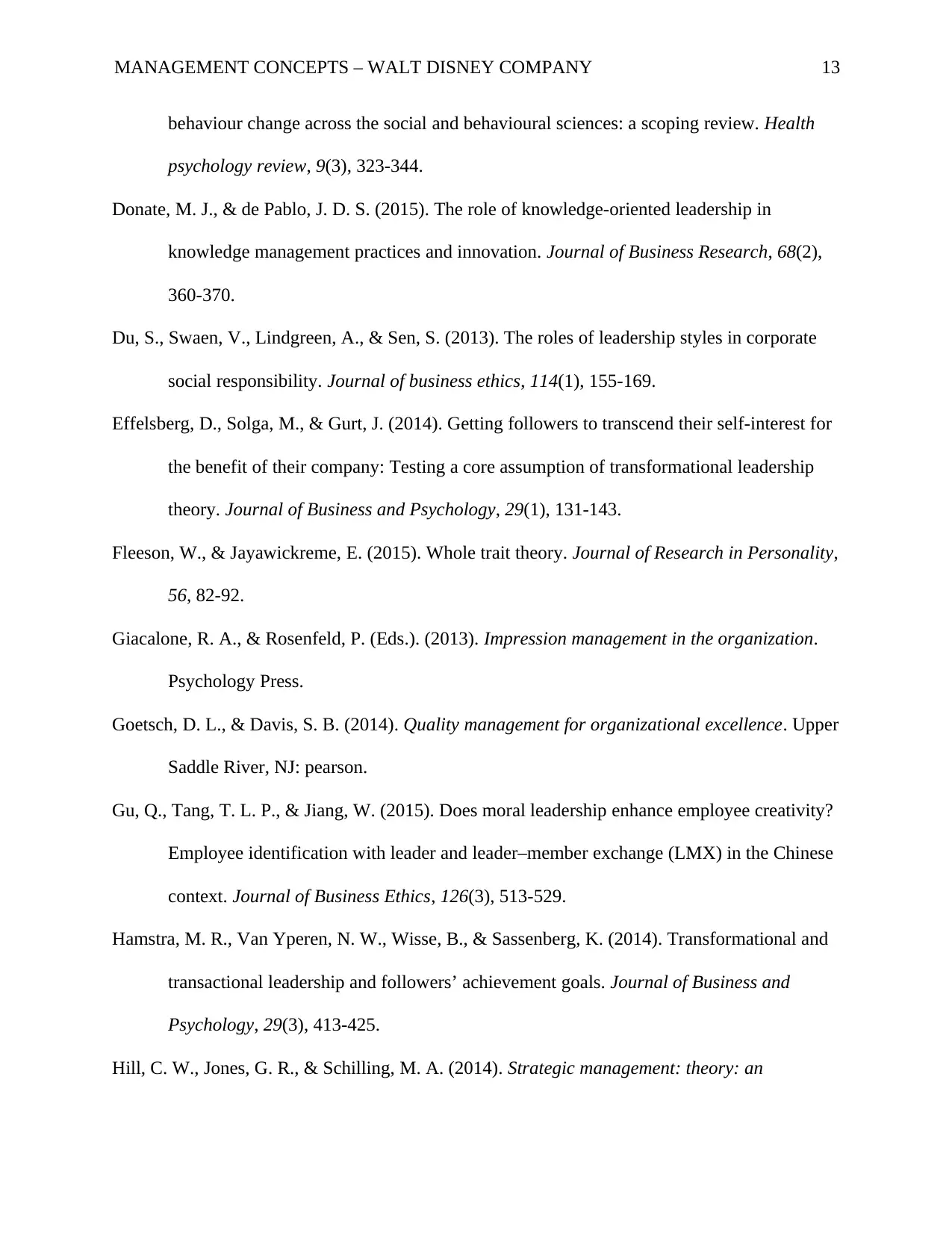
MANAGEMENT CONCEPTS – WALT DISNEY COMPANY 13
behaviour change across the social and behavioural sciences: a scoping review. Health
psychology review, 9(3), 323-344.
Donate, M. J., & de Pablo, J. D. S. (2015). The role of knowledge-oriented leadership in
knowledge management practices and innovation. Journal of Business Research, 68(2),
360-370.
Du, S., Swaen, V., Lindgreen, A., & Sen, S. (2013). The roles of leadership styles in corporate
social responsibility. Journal of business ethics, 114(1), 155-169.
Effelsberg, D., Solga, M., & Gurt, J. (2014). Getting followers to transcend their self-interest for
the benefit of their company: Testing a core assumption of transformational leadership
theory. Journal of Business and Psychology, 29(1), 131-143.
Fleeson, W., & Jayawickreme, E. (2015). Whole trait theory. Journal of Research in Personality,
56, 82-92.
Giacalone, R. A., & Rosenfeld, P. (Eds.). (2013). Impression management in the organization.
Psychology Press.
Goetsch, D. L., & Davis, S. B. (2014). Quality management for organizational excellence. Upper
Saddle River, NJ: pearson.
Gu, Q., Tang, T. L. P., & Jiang, W. (2015). Does moral leadership enhance employee creativity?
Employee identification with leader and leader–member exchange (LMX) in the Chinese
context. Journal of Business Ethics, 126(3), 513-529.
Hamstra, M. R., Van Yperen, N. W., Wisse, B., & Sassenberg, K. (2014). Transformational and
transactional leadership and followers’ achievement goals. Journal of Business and
Psychology, 29(3), 413-425.
Hill, C. W., Jones, G. R., & Schilling, M. A. (2014). Strategic management: theory: an
behaviour change across the social and behavioural sciences: a scoping review. Health
psychology review, 9(3), 323-344.
Donate, M. J., & de Pablo, J. D. S. (2015). The role of knowledge-oriented leadership in
knowledge management practices and innovation. Journal of Business Research, 68(2),
360-370.
Du, S., Swaen, V., Lindgreen, A., & Sen, S. (2013). The roles of leadership styles in corporate
social responsibility. Journal of business ethics, 114(1), 155-169.
Effelsberg, D., Solga, M., & Gurt, J. (2014). Getting followers to transcend their self-interest for
the benefit of their company: Testing a core assumption of transformational leadership
theory. Journal of Business and Psychology, 29(1), 131-143.
Fleeson, W., & Jayawickreme, E. (2015). Whole trait theory. Journal of Research in Personality,
56, 82-92.
Giacalone, R. A., & Rosenfeld, P. (Eds.). (2013). Impression management in the organization.
Psychology Press.
Goetsch, D. L., & Davis, S. B. (2014). Quality management for organizational excellence. Upper
Saddle River, NJ: pearson.
Gu, Q., Tang, T. L. P., & Jiang, W. (2015). Does moral leadership enhance employee creativity?
Employee identification with leader and leader–member exchange (LMX) in the Chinese
context. Journal of Business Ethics, 126(3), 513-529.
Hamstra, M. R., Van Yperen, N. W., Wisse, B., & Sassenberg, K. (2014). Transformational and
transactional leadership and followers’ achievement goals. Journal of Business and
Psychology, 29(3), 413-425.
Hill, C. W., Jones, G. R., & Schilling, M. A. (2014). Strategic management: theory: an
Paraphrase This Document
Need a fresh take? Get an instant paraphrase of this document with our AI Paraphraser
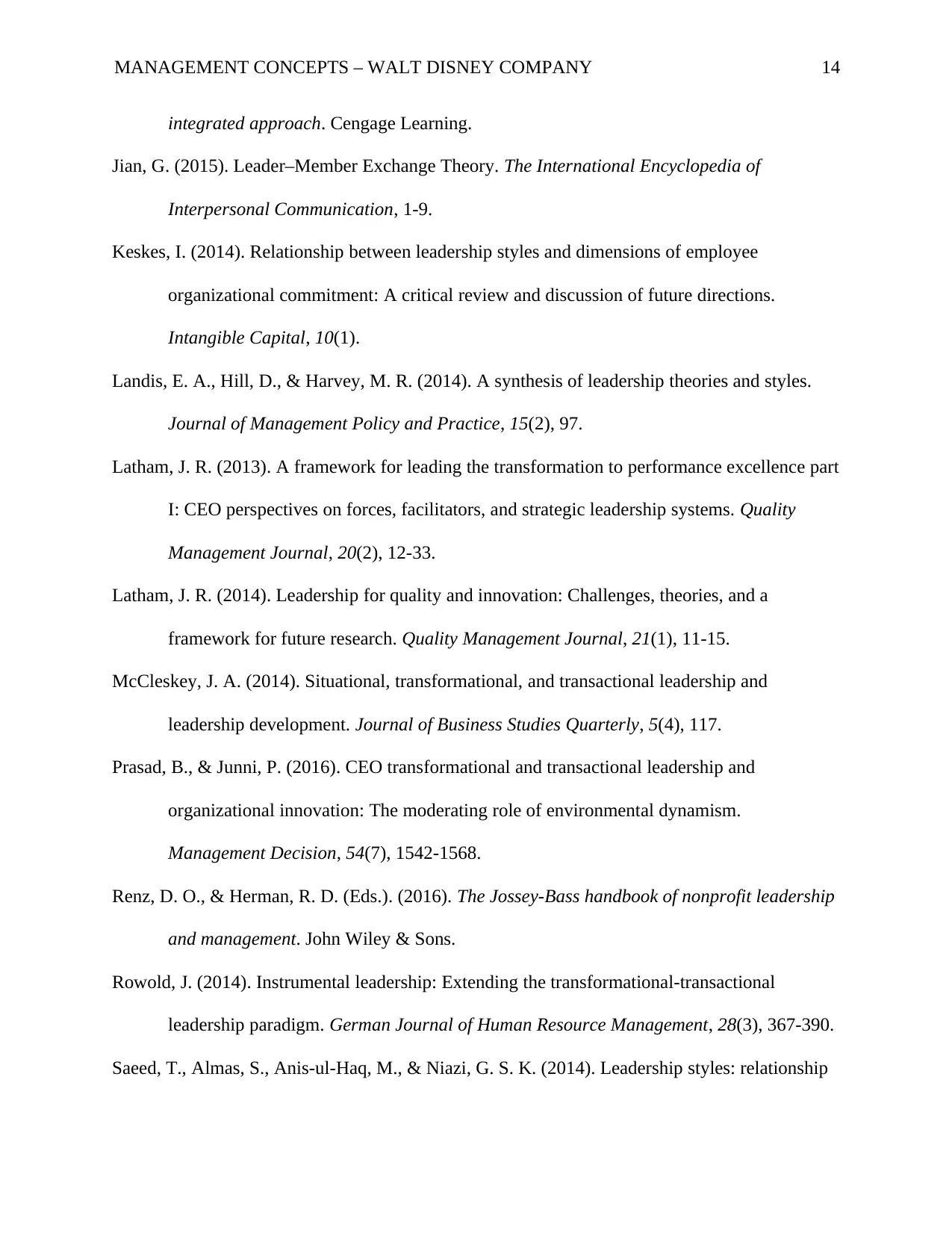
MANAGEMENT CONCEPTS – WALT DISNEY COMPANY 14
integrated approach. Cengage Learning.
Jian, G. (2015). Leader–Member Exchange Theory. The International Encyclopedia of
Interpersonal Communication, 1-9.
Keskes, I. (2014). Relationship between leadership styles and dimensions of employee
organizational commitment: A critical review and discussion of future directions.
Intangible Capital, 10(1).
Landis, E. A., Hill, D., & Harvey, M. R. (2014). A synthesis of leadership theories and styles.
Journal of Management Policy and Practice, 15(2), 97.
Latham, J. R. (2013). A framework for leading the transformation to performance excellence part
I: CEO perspectives on forces, facilitators, and strategic leadership systems. Quality
Management Journal, 20(2), 12-33.
Latham, J. R. (2014). Leadership for quality and innovation: Challenges, theories, and a
framework for future research. Quality Management Journal, 21(1), 11-15.
McCleskey, J. A. (2014). Situational, transformational, and transactional leadership and
leadership development. Journal of Business Studies Quarterly, 5(4), 117.
Prasad, B., & Junni, P. (2016). CEO transformational and transactional leadership and
organizational innovation: The moderating role of environmental dynamism.
Management Decision, 54(7), 1542-1568.
Renz, D. O., & Herman, R. D. (Eds.). (2016). The Jossey-Bass handbook of nonprofit leadership
and management. John Wiley & Sons.
Rowold, J. (2014). Instrumental leadership: Extending the transformational-transactional
leadership paradigm. German Journal of Human Resource Management, 28(3), 367-390.
Saeed, T., Almas, S., Anis-ul-Haq, M., & Niazi, G. S. K. (2014). Leadership styles: relationship
integrated approach. Cengage Learning.
Jian, G. (2015). Leader–Member Exchange Theory. The International Encyclopedia of
Interpersonal Communication, 1-9.
Keskes, I. (2014). Relationship between leadership styles and dimensions of employee
organizational commitment: A critical review and discussion of future directions.
Intangible Capital, 10(1).
Landis, E. A., Hill, D., & Harvey, M. R. (2014). A synthesis of leadership theories and styles.
Journal of Management Policy and Practice, 15(2), 97.
Latham, J. R. (2013). A framework for leading the transformation to performance excellence part
I: CEO perspectives on forces, facilitators, and strategic leadership systems. Quality
Management Journal, 20(2), 12-33.
Latham, J. R. (2014). Leadership for quality and innovation: Challenges, theories, and a
framework for future research. Quality Management Journal, 21(1), 11-15.
McCleskey, J. A. (2014). Situational, transformational, and transactional leadership and
leadership development. Journal of Business Studies Quarterly, 5(4), 117.
Prasad, B., & Junni, P. (2016). CEO transformational and transactional leadership and
organizational innovation: The moderating role of environmental dynamism.
Management Decision, 54(7), 1542-1568.
Renz, D. O., & Herman, R. D. (Eds.). (2016). The Jossey-Bass handbook of nonprofit leadership
and management. John Wiley & Sons.
Rowold, J. (2014). Instrumental leadership: Extending the transformational-transactional
leadership paradigm. German Journal of Human Resource Management, 28(3), 367-390.
Saeed, T., Almas, S., Anis-ul-Haq, M., & Niazi, G. S. K. (2014). Leadership styles: relationship
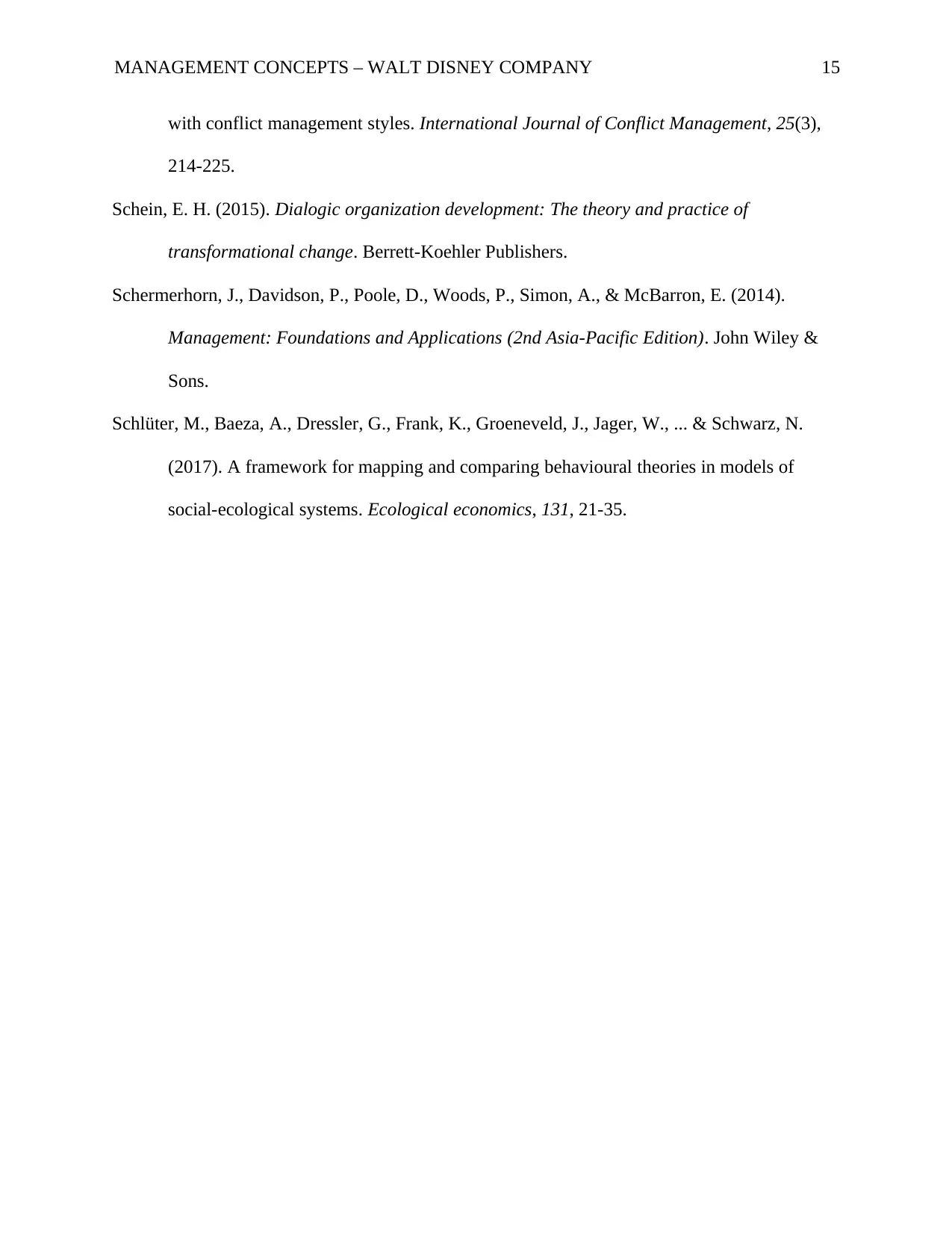
MANAGEMENT CONCEPTS – WALT DISNEY COMPANY 15
with conflict management styles. International Journal of Conflict Management, 25(3),
214-225.
Schein, E. H. (2015). Dialogic organization development: The theory and practice of
transformational change. Berrett-Koehler Publishers.
Schermerhorn, J., Davidson, P., Poole, D., Woods, P., Simon, A., & McBarron, E. (2014).
Management: Foundations and Applications (2nd Asia-Pacific Edition). John Wiley &
Sons.
Schlüter, M., Baeza, A., Dressler, G., Frank, K., Groeneveld, J., Jager, W., ... & Schwarz, N.
(2017). A framework for mapping and comparing behavioural theories in models of
social-ecological systems. Ecological economics, 131, 21-35.
with conflict management styles. International Journal of Conflict Management, 25(3),
214-225.
Schein, E. H. (2015). Dialogic organization development: The theory and practice of
transformational change. Berrett-Koehler Publishers.
Schermerhorn, J., Davidson, P., Poole, D., Woods, P., Simon, A., & McBarron, E. (2014).
Management: Foundations and Applications (2nd Asia-Pacific Edition). John Wiley &
Sons.
Schlüter, M., Baeza, A., Dressler, G., Frank, K., Groeneveld, J., Jager, W., ... & Schwarz, N.
(2017). A framework for mapping and comparing behavioural theories in models of
social-ecological systems. Ecological economics, 131, 21-35.
1 out of 15
Related Documents
Your All-in-One AI-Powered Toolkit for Academic Success.
+13062052269
info@desklib.com
Available 24*7 on WhatsApp / Email
![[object Object]](/_next/static/media/star-bottom.7253800d.svg)
Unlock your academic potential
© 2024 | Zucol Services PVT LTD | All rights reserved.




